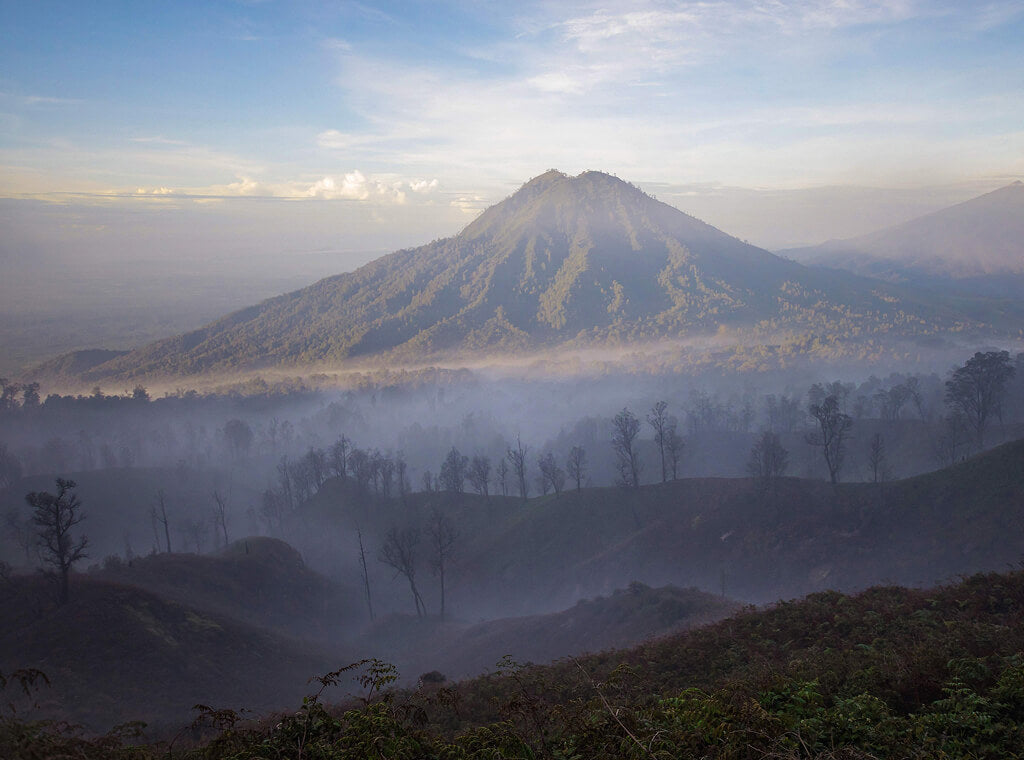
Roasting in June: Java Kayumas Village
Meet this month’s edition of our Small Batch Subscription series: Java Kayumas Village. This single origin coffee comes from the small farms of East Java; it’s a silky dark roast that makes a splash with notes of teakwood and blood orange zest, chocolate and vanilla. And if you think those tasting notes sound fantastic, just wait until you try it …
SMALL FARMS, BIG FLAVOR
This rare-find dark roast is grown by attentive hands in backyard farm lots so small that the coffee trees are practically right outside the farmers’ windows. In the rainy clime of the Javanese mountains, the wet-hulled processing method reigns supreme (more on that in a sec). The harvest, the processing, the long trip to our Roastery … it’s a complex journey for a complex coffee—and well worth it.
WET-HULL: WHAT, WHERE & WHY
Wet-hulled processing is also called Giling Balash, and it’s used throughout the Indonesian archipelago. It’s a rustic method that was invented as a way of drying the green bean more quickly in a rainy, wet environment. The coffee beans are harvested, pulped, and fermented, then rinsed clean the next morning. All this is done by hand before the beans are collected at a mill to be hulled and dried some more.
The beans arrive at the mill only partially dried and with the parchment skin powerfully attached. To remove it, the hulling machines apply lots of rough and tumble pressure, and the beans can get pretty squashed and nicked. But don’t judge their quality by their beat-up appearance—they only look a little rough. The flavor is still incredible (not too surprising when we know the wet-hulling process reliably brings out spicy, herbal tasting notes).
ROAST MAGIC
Ok, maybe it’s not magic, but our roasters are so good it seems like it. After the beans make their way across oceans to finally arrive at our Roastery, we give them our classic deep, dark roast treatment. Our roasters are masters of their craft, using their five senses (not automated machines) to unlock each bean's flavor potential, and fine-tuning the nuances of each blend and single origin they roast. Still with us? Keep reading to the bottom and see what the roasters said about this coffee.
IT’S A MATTER OF TASTE
The richness of this roast brings out notes of teakwood, blood orange zest, and chocolate with a hit of sweet vanilla bean. To enhance its spicy-complex profile, we recommend brewing this special single origin in a press pot or as pour over, if you’ve got the equipment. Or maybe do a brew taste test alongside drip to capture the nuances brew style bring out of a coffee this complex. Whichever way you brew it, you’ll savor it.
FRESH FROM THE ROASTERY
When the beans arrived at the Roastery, we noticed they were all different sizes and colors—and there were some clear giveaways about the region they’re from. There were large Sulawesi-like bluish green beans with a rough matte texture. There were also medium sized olive greens, browns, and even some yellow beans. They all had a rough looking chaff line similar to Sumatra beans. Their un-roasted aroma was fresh and woody, and only one bean still had its parchment (sometimes one slips through the hulling machine!).
The roasts had very consistent times and curves, however it was a bit difficult to get this Java roasted dark. When we saw the temperature at the end of the second roast, we thought for sure we had misjudged the color and gone too dark—turns out it was actually right on the money. And once we realized how far we needed to take it, the roast was consistent.
The popping sound at first crack was almost inaudible when we first roasted a batch, but we played around with it and were able to pull out quiet but sharp snaps. It turned out the coffee was sensitive to the ambient heat of the machine as it warmed—a good reminder that each coffee is unique. While we roasted, we picked up sweet and spicy smells with some faint chocolate notes present.
After roasting comes cupping. We evaluated four profiles in a blind, randomized cupping with six tasters. We were initially split between two very different profiles, but after a long discussion and tasting each sample all the way down to room temp, we ultimately aligned on one.
The winner (and the one you’ll bring home) had great aromatics and a lot of true-to-origin character. When we broke the crust: aromatic wood, brown sugar, sweet maple, and floral undertones. In the cup: impressive dimension, beautiful while cooling, bright and juicy. We detected notes of tropical fruit, citrus, warming spice, wood, and a touch of black pepper (seriously complex). We also tried it as a flash brew and it was a real delight.
-John Nicolini and Michael Madden, Roasters; Jamie Smith, R&D
LIMITED RELEASE PEET’S COFFEES
You might think that a monthly coffee subscription sounds amazing in and of itself, but Peet’s Small Batch coffee-of-the-month takes it a step further. These are microlot coffees, which is why you can only find them at peets.com and you can only access them if you have a subscription. They’re special—their rarity means they can sell out—fast. Subscribing ensures you get to taste each one of these remarkable lots. And if you’re a tried-and-true fan and subscribe to of one of our other coffees or subscription series, not to worry: you can do an add-on of this limited release to your next shipment. At least, while it lasts.


